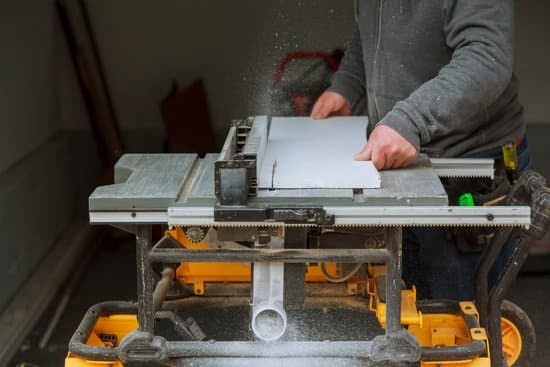Woodworking is a craft that has been practiced for centuries, and the tools used in this discipline play a crucial role in shaping and creating beautiful wooden creations. In this article, we will explore the art of making wooden woodworking tools, and understand the significance of using handmade tools in woodworking projects. From selecting the right type of wood to shaping and finishing, we will provide a comprehensive guide on how to make wooden woodworking tools.
Using wooden woodworking tools not only adds a traditional touch to your workshop but also allows for a deeper connection to the craft itself. The sense of pride and satisfaction that comes from using handmade tools is unparalleled. Additionally, wooden tools are known for their durability, strength, and ability to absorb shock – making them an essential choice for woodworkers.
In the following sections, we will delve into the process of selecting the right type of wood for woodworking tools, discuss the necessary tools and materials needed for crafting wooden tools, and provide step-by-step guides for making a wooden hammer, chisel, and mallet. We will also share tips for shaping and finishing these handmade tools to ensure longevity and precision in your woodworking projects.
Whether you are new to woodworking or an experienced craftsman, understanding the importance of using handmade wooden woodworking tools is essential for honing your skills and enhancing your craft.
Selecting the Right Type of Wood for Woodworking Tools
When it comes to making wooden woodworking tools, choosing the right type of wood is crucial for both the functionality and longevity of the tools. Here are some types of wood that are commonly used for making woodworking tools:
- Ash: Known for its strength and durability, ash is a popular choice for making handles for hammers and chisels.
- Oak: Oak is a dense and sturdy wood that is often used for making mallets and chisel handles due to its resistance to wear and tear.
- Maple: Maple is a great option for woodworking tools as it is strong, smooth, and resistant to splitting, making it suitable for various tool components.
In addition to the type of wood, it’s important to consider the grain pattern and orientation when selecting wood for woodworking tools. Look for straight-grained pieces with minimal knots or irregularities, as these can weaken the overall structure of the tool.
Keep in mind that sustainability is also an important factor when choosing wood for woodworking tools. Opt for responsibly sourced or reclaimed wood to minimize environmental impact and support sustainable practices in woodworking.
Overall, choosing the right type of wood is essential in creating high-quality wooden woodworking tools that are not only functional but also have a beautiful finish.
Tools and Materials Needed for Making Wooden Woodworking Tools
Woodworking is a craft that requires skill, precision, and the right tools. When it comes to creating your own woodworking tools from wood, it is essential to have the necessary materials and equipment. Here is a list of tools and materials that you will need to make your own wooden woodworking tools.
First and foremost, you will need the proper type of wood for your project. Select a hardwood such as maple, oak, or cherry for durability and strength. Avoid softwoods like pine or cedar as they may not hold up well to the wear and tear of woodworking.
In addition to the wood itself, you will also need a set of basic hand tools including chisels, saws, carving knives, gouges, mallets, clamps, and rasps. These tools will be essential for shaping and carving the wood into the desired shape for your woodworking tool.
Furthermore, having safety equipment such as goggles, gloves, and a dust mask is crucial when working with wood and woodworking tools. Safety should always be a priority when working on any DIY project.
Following these guidelines will help you create your own wooden woodworking tools using quality materials and making sure that your finished products are safe to use while providing great results in your woodworking projects.
Step-by-Step Guide to Making a Wooden Hammer
Wooden hammers are essential tools in any woodworking workshop. They are used for driving chisels, carving and shaping wood, and assembling joints. Making a wooden hammer is a rewarding project that allows woodworkers to create a tool that is unique to their specific needs. In this section, we will provide a step-by-step guide on how to make a wooden hammer.
To begin making a wooden hammer, the first step is selecting the right type of wood for the head and handle. Hardwoods such as ash, oak, or hickory are ideal for the head of the hammer due to their durability and ability to withstand impact. For the handle, woods such as maple, beech, or cherry provide strength and stability.
Once the appropriate wood has been chosen, the next step is gathering the necessary tools and materials. This includes a saw for cutting the wood to size, carving tools for shaping the head and handle, sandpaper for smoothing out rough edges, wood glue for assembly, and finish such as beeswax or oil for protection and aesthetics.
After gathering all tools and materials needed, it’s important to carefully follow each step in order to make an effective wooden hammer. The process involves cutting the wood to size, shaping and carving the head and handle according to desired specifications, assembling the pieces with wood glue, sanding any rough edges or surfaces, and applying finish for protection. Following these steps will result in a well-crafted wooden hammer that can be used for many woodworking projects.
Making your own wooden woodworking tools not only allows for customization but also provides an opportunity to appreciate craftsmanship and handmade items. Crafting your own woodworking tools connects you with timeless woodworking traditions while creating functional tools designed specifically for your needs. Whether it’s a small mallet or delicate chisel – some projects simply require you to create your own tool so that you can have exactly what is required at hand.
Step-by-Step Guide to Making a Wooden Chisel
Woodworking chisels are essential tools for any woodworker, and making your own wooden chisel can be a rewarding and fulfilling experience. Not only does making your own wooden woodworking tools allow you to customize them to your specific needs, but it also gives you a deeper appreciation for the craftsmanship of your work. In this section, we will provide a step-by-step guide on how to make a wooden chisel.
Materials Needed
Before starting on making a wooden chisel, you will need to gather the necessary materials and tools. The materials needed for making a wooden chisel include the appropriate type of wood for the handle and steel for the blade. You will also need various woodworking tools such as saws, chisels, sandpaper, and wood carving tools.
Step-by-Step Guide
- Begin by selecting a suitable piece of hardwood for the handle of the chisel. Maple, oak, or ash are good options due to their durability.
- Cut the wood to the desired length for your handle using a saw, and then carve and shape it to your preference using woodworking tools.
- Next, select the steel for the blade of the chisel and shape it according to the size and angle you desire using a grinder or file.
- Once both parts are ready, drill an appropriate hole in one end of the handle to insert the blade securely.
- Finally, attach the blade to the handle with epoxy or another appropriate adhesive, secure it firmly in place, and allow it time to dry before use.
Finishing Touches
After assembling your wooden chisel, take time to shape all edges and corners carefully with sandpaper or other finishing tools so that they are smooth with no sharp edges that could cause injury during use. Additionally, applying varnish or oil can protect and prolong the life of your handmade wooden woodworking tool.
By following these steps on how to make a wooden chisel, you can create a unique tool that fits perfectly in your hand while gaining valuable insight into traditional woodworking techniques and craftsmanship. Experimenting with different designs can further enhance your woodwork projects through personalized tools that cater specifically to your needs as a craftsman or hobbyist.
Step-by-Step Guide to Making a Wooden Mallet
Wooden mallets are essential tools in any woodworking shop. They are used for a variety of tasks such as driving chisels and assembling joinery. Making a wooden mallet is a relatively simple woodworking project that can be completed in a few hours. Using the right techniques and materials will result in a durable and functional tool that will last for years to come.
Choosing the Right Wood
The first step in making a wooden mallet is selecting the right type of wood. Hardwoods such as maple, oak, or beech are ideal choices for making a durable mallet that can withstand heavy use. Look for hardwoods that are free from knots and defects, as these can weaken the mallet over time.
Gathering Tools and Materials
To make a wooden mallet, you will need a few basic tools and materials including:
- A saw
- Chisels
- Mallet head template or design
- Sandpaper
- Wood glue
- Clamps
Step-by-Step Guide
- Begin by cutting the wood to the desired dimensions for the mallet head and handle.
- Use a chisel to create notches on the top of the mallet head where the handle will be attached.
- Apply wood glue to the notches and insert the handle into place.
- Clamp the mallet head and handle together securely while the glue dries.
- Once dry, shape and smooth out any rough edges using sandpaper.
Making wooden woodworking tools like a mallet requires patience, precision, and attention to detail. By following these steps, you can create a beautiful and functional tool that will serve you well in your woodworking endeavors.
Tips for Shaping and Finishing Wooden Woodworking Tools
When it comes to making wooden woodworking tools, shaping and finishing are crucial steps that determine the functionality and durability of the tools. The process of shaping and finishing wooden woodworking tools requires attention to detail and precision to ensure that the tools will perform effectively. In this section, we will discuss some essential tips for shaping and finishing wooden woodworking tools to help you create high-quality, handmade tools for your woodworking projects.
The first step in shaping wooden woodworking tools is selecting the right type of wood that is suitable for toolmaking. Hardwoods such as oak, maple, and cherry are popular choices for making woodworking tools due to their strength and durability.
Once you have selected the appropriate wood, it is important to use sharp carving or turning tools to shape the wood according to the design of the tool you intend to make. Pay close attention to the measurements and angles to ensure that the resulting tool will be functional and balanced.
After shaping the wooden woodworking tool, the next crucial step is finishing. This involves sanding the wood surface to achieve a smooth texture and removing any rough spots or imperfections. Start with coarse-grit sandpaper and gradually work your way up to finer grits until you achieve a polished finish. Additionally, applying a protective finish such as linseed oil or beeswax can help enhance the longevity of the wooden tool by protecting it from moisture and wear.
Conclusion
In conclusion, the art of making wooden woodworking tools is a craft that requires precision and patience. Throughout this article, we have explored the importance of using handmade wooden tools in woodworking and the satisfaction that comes from crafting them yourself. By selecting the right type of wood and following the step-by-step guides provided, anyone can learn how to make wooden woodworking tools.
Craftsmanship plays a crucial role in creating high-quality woodworking tools that are not only functional but also aesthetically pleasing. The process of handcrafting these tools allows for customization and attention to detail, resulting in tools that are tailored to individual needs and preferences. Furthermore, using handmade wooden tools adds a personal touch to woodworking projects and creates a stronger connection between the craftsman and their work.
Ultimately, the significance of craftsmanship and handmade wooden woodworking tools cannot be overstated. Aspiring woodworkers should take advantage of the opportunity to not only create their own tools but also enhance their skills through this hands-on process.
The satisfaction of using tools crafted with care and precision is an experience like no other in the world of woodworking. So, if you are interested in learning how to make wooden woodworking tools, embrace the journey of craftsmanship and discover the joy of using handmade tools in your craft.
Frequently Asked Questions
How to Get Free Woodworking Tools?
Getting free woodworking tools can be possible through various avenues such as joining online forums or community groups where members may be giving away or selling their used tools at a low cost.
Additionally, reaching out to friends or family members who may have unused tools they are willing to part with could also be a way to acquire woodworking tools for free.
What Tools Are Needed to Begin Woodworking?
To begin woodworking, some essential tools are needed such as a saw (circular saw, hand saw, or jigsaw), a power drill, chisels, hammer, measuring tape, clamps, and sandpaper. These basic tools are necessary for cutting, shaping, drilling, assembling, and finishing wood projects. As skills and projects advance, additional specialized tools can be added to the collection.
What Sort of Tools Are Required to Make a Wooden Model?
Making a wooden model requires specific tools like carving knives or chisels for shaping the wood, sandpaper for smoothing and refining surfaces, precision measuring tools such as calipers and rulers for accurate dimensions, and small clamps to hold pieces together during assembly.
Depending on the complexity of the model being made, additional specialty tools like mini saws or routers may also come in handy to achieve intricate details.

Hi everyone! I’m a woodworker and blogger, and this is my woodworking blog. In my blog, I share tips and tricks for woodworkers of all skill levels, as well as project ideas that you can try yourself.





